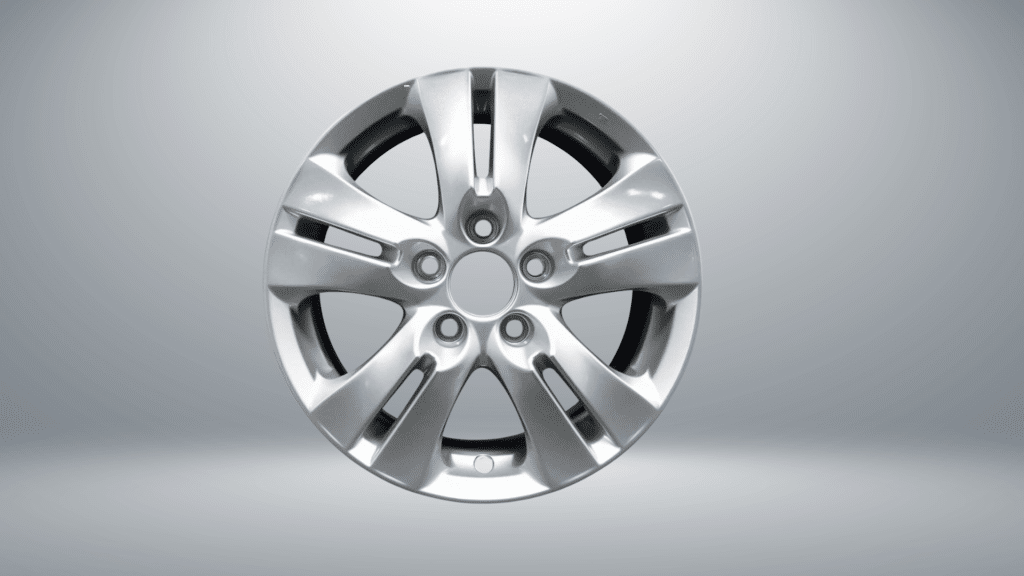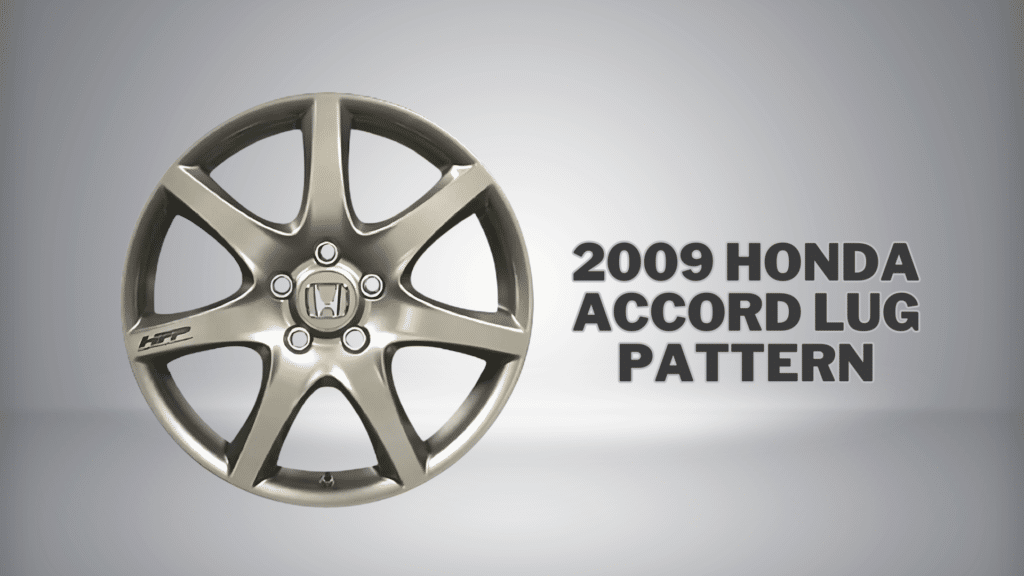Knowing the correct lug pattern is crucial if you plan to replace or upgrade the wheels on your 2009 Honda Accord.
The lug pattern is the number of bolts on the wheel and the distance between them.
If the pattern doesn’t match your car, the wheels won’t fit properly, which could lead to safety risks, poor handling, or even damage to your vehicle.
In this guide, I’ll explain the lug pattern for the 2009 Honda Accord and why it’s so important.
I’ll also guide you on how to measure the lug pattern yourself and check if the wheels are compatible with your car.
With the right information, you’ll be able to choose the right wheels and avoid costly mistakes confidently.
What is a Lug Pattern?
The lug pattern, also known as the bolt pattern, refers to the number of bolts on the wheel and the distance between them.
The lug pattern helps the wheel attach securely to the vehicle’s wheel hub.
Each vehicle has a lug pattern matching the number of bolt holes and the distance between them.
For example, the 2009 Honda Accord has a 5×114.3mm lug pattern.
This means there are 5 bolt holes on the wheel, and the distance between the centers of adjacent bolt holes is 114.3mm.
This is important because it ensures the wheel fits perfectly on the vehicle’s wheel hub.
Why Does the Lug Pattern Matter?
The lug pattern is one of the most important factors in choosing new wheels for your car.
If the lug pattern doesn’t match, the wheel will not fit securely, which can lead to issues such as:
- Misalignment: The wheel won’t sit properly, which can cause uneven wear on the tires and poor handling.
- Safety Concerns: An incorrect lug pattern can cause the wheel to come loose, leading to dangerous driving conditions.
- Vibrations: A mismatched lug pattern can cause vibrations while driving, affecting the comfort and stability of your ride.
Lug Pattern for the 2009 Honda Accord

5×114.3mm Lug Pattern
For the 2009 Honda Accord, the 5×114.3mm lug pattern is the standard.
This means the vehicle has 5 bolt holes on the wheels, and the distance between the centers of two adjacent bolt holes is 114.3mm.
This pattern is common in many mid-size sedans and some compact vehicles, making it easier to find compatible wheels.
Hub Bore Size for the 2009 Honda Accord
The hub bore size is another important measurement.
The hub bore is the diameter of the hole in the center of the wheel that fits over the hub of your vehicle.
For the 2009 Honda Accord, the hub bore size is 64.1mm.
When selecting new wheels, you’ll need to make sure that the hub bore matches the size of your vehicle’s hub.
If the hub bore is too small or too large, the wheel may not sit properly, leading to poor performance or vibrations.
Offset and Backspacing
The offset and backspacing are also important factors when choosing new wheels for your 2009 Honda Accord.
- Offset: It refers to how far the wheel sits in or out from the centerline of the vehicle. A positive offset means the wheel is closer to the vehicle, while a negative offset means it sticks out further.
- Backspacing: is the distance from the back of the wheel to the mounting surface. It determines how the wheel fits within the wheel well. Incorrect offset or backspacing can cause rubbing against the suspension or body of the vehicle, leading to poor handling and possible damage.
How to Measure the Lug Pattern for Your 2009 Honda Accord
1. Count the Number of Bolt Holes
The first step in measuring the lug pattern is to count the number of bolt holes on your wheel.
For the 2009 Honda Accord, there will be five bolts on each wheel.
This is the first part of the 5×114.3mm lug pattern.
2. Measure the Distance Between Bolt Holes
Next, measure the distance between the centers of two adjacent bolt holes.
This is the crucial measurement that determines the second part of the lug pattern.
For the 2009 Honda Accord, the distance should be 114.3mm. This is the second part of the 5×114.3mm pattern.
You can measure this distance using a tape measure or a caliper.
Be sure to measure from the center of one bolt hole to the center of the next bolt hole.
3. Verify the Measurements
Once you have the measurements, double-check to make sure they match the 5×114.3mm pattern.
If unsure, you can consult your car owner’s manual or use an online tool to verify the lug pattern.
Choosing the Right Wheels for Your 2009 Honda Accord
Look for the Correct Lug Pattern
The first step in choosing the right wheels for your 2009 Honda Accord is to make sure they have the 5×114.3mm lug pattern.
You can find this information in the wheel specifications or consult a tire shop for advice.
Check the Hub Bore Size
Next, make sure the hub bore size of the wheels matches the 64.1mm hub bore size of your 2009 Honda Accord.
If the hub bore size is too small or too large, the wheels won’t fit properly.
Consider Wheel Size and Offset
The wheel size, including the diameter and width, should also be compatible with your car.
The 2009 Honda Accord typically uses wheels that range from 16 to 18 inches in diameter, depending on the trim level.
Be sure to choose a wheel size that fits well within your vehicle’s wheel wells.
Check the Tire Compatibility
Finally, make sure the tires you plan to use with your new wheels are compatible with the wheels’ size and load rating.
Check the manufacturer’s specifications for the tires and the wheels to ensure they’re a good match.
How to Ensure a Proper Fit
Test Fit Before Installing
Before fully installing new wheels on your 2009 Honda Accord, it’s a good idea to test-fit them first.
Place the wheel on the hub and check for proper fitment.
Make sure the bolt holes line up correctly, and ensure that the wheel sits flush against the hub.
Check for Clearance
Check the clearance between the wheel and other parts of the vehicle, such as the suspension and brake components.
If the wheels are too large, they may rub against these parts, causing performance issues.
Tighten the Lug Nuts Correctly
When installing the wheels, always use a torque wrench to tighten the lug nuts to the manufacturer’s recommended torque specifications.
This helps prevent over-tightening or under-tightening, both of which can cause damage to the threads or lead to improper wheel installation.
Comparison of the 2009 Honda Accord Lug Pattern with Other Vehicles
| Vehicle Model | Bolt Pattern | Wheel Size Range | Hub Bore Size | Other Notes |
|---|---|---|---|---|
| 2009 Honda Accord | 5×114.3mm | 16-18 inches | 64.1mm | The standard for most trims |
| Toyota Camry | 5×114.3mm | 16-18 inches | 60.1mm | Compatible with Honda Accord wheels |
| Nissan Altima | 5×114.3mm | 16-18 inches | 66.1mm | Same bolt pattern, compatible with the Accord |
| Chevrolet Malibu | 5x115mm | 16-18 inches | 70.3mm | Slightly different bolt pattern (5x115mm), not directly compatible |
| Hyundai Sonata | 5×114.3mm | 16-18 inches | 67.1mm | Same bolt pattern; check wheel size for compatibility |
| Ford Fusion | 5×114.3mm | 16-18 inches | 63.3mm | Compatible, but verify offset and wheel size |
Key Takeaways:
- 2009 Honda Accord shares the 5×114.3mm bolt pattern with many other vehicles like the Toyota Camry, Nissan Altima, and Hyundai Sonata, making it easy to swap wheels between these models.
- Some vehicles, like the Chevrolet Malibu, use a 5x115mm bolt pattern, which is different and not directly compatible with the Accord without adapters.
- Always check hub bore size and wheel size compatibility before swapping wheels.
How to Maintain Lug Patterns on Your 2009 Honda Accord
Maintaining the lug pattern on your 2009 Honda Accord is essential for ensuring that your wheels fit securely and your vehicle performs optimally.
Proper care can help you avoid issues like wheel misalignment, vibrations, and even accidents.
Here are some tips to help you maintain the lug patterns and ensure your wheels stay in great condition.
Regularly Check the Lug Nut Tightness
Once you install new wheels on your 2009 Honda Accord, always double-check the tightness of the lug nuts.
Over time, the lug nuts may loosen due to driving vibrations.
Loosened lug nuts can cause the wheels to become misaligned or come off while driving, which can be dangerous.
- Tip: After installing new wheels, use a torque wrench to tighten the lug nuts to the manufacturer’s recommended torque specification.
- Tip: Periodically check the lug nuts during regular vehicle maintenance, especially after long drives or tire changes.
Keep the Lug Holes Clean
Dirt, rust, and debris can accumulate around the lug holes and the wheel hub, affecting the wheel fitment.
Over time, this buildup can cause the lug nuts not to tighten properly, leading to a loose wheel.
- Tip: Clean the lug holes regularly using a wire brush to remove any buildup of rust or dirt.
- Tip: Wipe the threads of the lug bolts before installing the wheel to ensure a snug fit and to prevent any rust buildup.
Inspect for Wear and Tear
Check the condition of your lug nuts and bolts regularly to ensure they are not damaged.
Damaged or worn lug bolts can cause your wheels not to be securely attached, leading to vibrations or, worse, a wheel coming off while driving.
- Tip: If you notice any wear or damage on the lug nuts or bolts, replace them immediately.
- Tip: Ensure the lug nuts’ threads are still intact and not stripped.
Check the Fitment of the Wheels
It’s important to make sure your wheels are still fitting properly after you’ve installed them.
Misalignment, rubbing, or vibrations are signs that something may be wrong with the fitment, possibly due to the lug pattern or other factors.
- Tip: When you swap wheels or tires, check for any rubbing against the wheel well or suspension parts. It may be time to recheck the fitment if you notice anything unusual.
- Tip: Make sure that the wheels are sitting flat against the hub. If there’s any gap, the lug bolts might not engage properly, causing alignment issues.
Tips for Maintaining Lug Patterns
Don’t Over-tighten Lug Nuts
While it’s important to tighten the lug nuts properly, over-tightening can damage the threads on the lug bolts or the wheel.
Always use a torque wrench to tighten the lug nuts to the correct specification.
Rotate Your Tires Regularly
Regular tire rotation can help maintain even wear on your wheels and prevent any issues with alignment.
This also gives you the opportunity to check the lug nuts and make sure everything is secure.
Store Extra Lug Nuts Properly
If you’re keeping spare lug nuts or bolts, make sure they’re stored in a dry, rust-free place.
Rust or moisture can affect their performance, making them harder to install when needed.
Use Anti-Seize Lubricant
Anti-seize lubricant can help keep the threads on your lug nuts and bolts in good condition.
This can prevent rust and corrosion and make it easier to remove the lug nuts in the future.
Avoid Mixing Lug Nut Types
Don’t mix and match different types of lug nuts, as this can cause issues with how your wheels fit.
Always use the same type of lug nuts that come with your vehicle or wheels.
Common Mistakes to Avoid When Maintaining Lug Patterns
Using Incorrect Lug Nuts
One of the most common mistakes when replacing or installing wheels is using incorrect lug nuts.
The wrong size or type of lug nuts can lead to improper fitment, causing the wheel to come loose or misaligned.
- Avoid this mistake: Always use lug nuts that are the same size and thread type as the original ones. If you’re unsure, check your vehicle’s manual or consult a professional.
Neglecting Regular Checks
Skipping regular checks of the lug nuts and wheel fitment can lead to serious safety issues.
Over time, vibrations can loosen lug nuts, and wheel misalignment can cause uneven tire wear and affect the car’s performance.
- Avoid this mistake: Regularly check your lug nuts’ tightness and inspect the condition of the wheels. If you notice any signs of damage or wear, replace the parts immediately.
Improper Torqueing
Over-tightening or under-tightening lug nuts can both lead to problems.
Over-tightening can damage the threads, while under-tightening can cause the wheel to come loose.
- Avoid this mistake: Always use a torque wrench to tighten lug nuts to the manufacturer’s recommended torque specifications. This ensures proper fitment and avoids damaging the threads.
Ignoring Hub Bore Size
Sometimes, people overlook the importance of matching the hub bore size when installing new wheels.
The hub bore is the center hole of the wheel that fits onto the vehicle’s hub.
If the hub bore size is incorrect, the wheel might not sit flush, leading to vibrations or even wheel failure.
- Avoid this mistake: Double-check that the hub bore size matches your vehicle’s specifications to ensure a proper fit.
Not Cleaning the Wheel and Hub
Failing to clean the wheel and hub before installation can lead to dirt and debris getting trapped between the wheel and the hub, preventing the wheel from sitting correctly.
- Avoid this mistake: Clean both the hub and the lug holes before installing your wheels. This will help ensure the wheel sits properly and that the lug nuts tighten securely.
Ignoring Thread Damage
Worn or damaged threads on the lug nuts or bolts can cause the wheel to be installed improperly.
If the lug nuts don’t thread correctly, the wheel might not be securely attached.
- Avoid this mistake: Regularly inspect the threads on the lug nuts and bolts. If any damage is noticed, replace the damaged parts immediately to maintain a secure fit.
Conclusion
Maintaining the correct lug pattern on your 2009 Honda Accord is key to ensuring your wheels fit properly, and your car runs safely.
The 5×114.3mm lug pattern is standard for this model, and ensuring your new wheels match this pattern is the first step to avoiding alignment issues, vibrations, and safety problems.
Along with the lug pattern, remember to consider other important factors like hub bore size and wheel offset.
Regularly checking the tightness of your lug nuts, cleaning the wheel and hub, and inspecting for any wear or damage can help you maintain a secure fit.
This simple maintenance can prevent many common problems.
Always use the right tools, like a torque wrench, to tighten the lug nuts properly.
Taking care of these small details will help you enjoy a smoother, safer ride and help your car perform at its best for years.
Frequently Asked Questions
What is the lug pattern for a 2009 Honda Accord?
The lug pattern for a 2009 Honda Accord is 5×114.3mm. This means there are 5 bolt holes, and the distance between the bolt holes is 114.3mm.
Can I use wheels from other cars on my 2009 Honda Accord?
You can, but the bolt pattern must match. The 5×114.3mm pattern is common in many vehicles, but be sure to check other factors like hub bore size and wheel size.
What is the hub bore size for a 2009 Honda Accord?
The hub bore size for the 2009 Honda Accord is 64.1mm. This is the diameter of the hole in the center of the wheel that fits over the vehicle’s wheel hub.
How often should I check the lug pattern on my 2009 Honda Accord?
You should check the lug pattern when replacing your wheels or tires or if you’re upgrading to aftermarket wheels. This ensures the new wheels fit correctly and safely.


